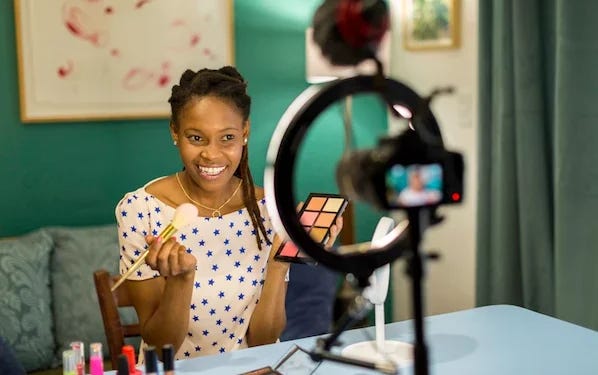10 Trends Changing Africa’s Creative Economy in 2026
How streaming, short-form content, AI, investment and more are reshaping cultural production on the continent
Africa’s creative economy is entering a new era. While the continent has long been known for its rich creative talent — music, film, fashion, design — what’s changing now is the infrastructure, the platforms, the technology, the investment and the very nature of what “creation” means. Below are 10 trends we believe are shifting the landscape — and each one offers both opportunity and challenge for African creators, entrepreneurs and policymakers.
1. Streaming & Illegal Streaming / Piracy
The shift to streaming is foundational. On one hand, streaming platforms open up African content to global audiences, enabling creators in Lagos, Nairobi or Accra to potentially reach millions. But on the other hand, illegal streaming and piracy are major structural drains on the creative economy.
In Kenya, for instance, piracy costs the creative industry billions — with illegal streaming, cable “sambaza” services and unauthorised downloads undermining revenue. As one report notes, piracy “…undermines the creative backbone of the industry”
This duality means that while streaming has the potential to scale African content, the ecosystem is still weakening the base: revenue is lost, talent can’t reinvest, and distribution pipelines remain fragmented.
Why it matters
Creators and production houses lose income → limits reinvestment in quality.
Investors become wary because monetisation is uncertain.
Audiences may consume content, but the value seldom returns into the ecosystem.
What to watch
New anti-piracy innovations (e.g., Kenya’s platform model where movie shops download legitimate content to flash drives). WIPO
Growth of local streaming services tailored to African markets (data-light, mobile first).
Partnerships between global platforms and African producers — and whether revenue share is fair.
2. The Language of the Internet: Short-Form Content
In the age of the scroll and the swipe, short-form content (Reels, TikTok videos, YouTube shorts) is becoming dominant — and Africa is no exception. The continent’s creators are mastering this format: local dialects, strong visuals, cultural remixing, viral memes.
This plays into Africa’s youth-rich, mobile-first demographics.
The relevance of this trend is massive: it expands who can create, how fast they can create, and how quickly content travels. But the flip side is that monetisation often lags behind attention. Viral reach doesn’t always translate into sustainable income for creators.
Implications:
More creators enter the ecosystem because barriers to entry are lower, but competition intensifies.
Brands and marketers shift budget towards shorter formats and influencer / creator-led content.
Platforms that provide native monetisation features for short-form creators will gain advantage; if African markets lag here, creators may “export” themselves or monetise via diaspora audiences.
3. AI-Generated Content Overtaking Human-Generated Content
One of the most disruptive trends: the growth of AI-generated content. On the continent, this is both opportunity and question mark.
For example, African studios are creating virtual influencers, avatars, AI-driven models trained on African languages and cultural datasets.
This means: faster production, new formats (text-to-video, avatars, AI voices), and potential for scale. But it also raises concerns: who owns the dataset? Are African creators being bypassed? Is authenticity lost? Are jobs replaced?
Why it matters:
Creators who adopt AI tools may scale faster and experiment more.
But there’s a risk of devaluing human-led creative work and exacerbating inequality if the tools are controlled externally.
Intellectual property and rights become more complex: if an AI model is trained on Yoruba folklore, who owns the output?
What to watch:
African policy on AI and creative industries: dataset ownership, local regulation.
Creators using AI as augmentation rather than replacement — hybrid models.
Platforms offering AI tools for African languages, local culture.
4. Increasing Local and International Investment
There has been a noticeable uptick in investment into Africa’s creative economy. Both local venture firms and international brands/investors are recognising the potential.
According to recent commentary:
The continent’s creative industries are gaining global interest, but local support remains weak.
And African creator platforms are beginning to see meaningful backing.
Why this matters:
More investment → higher production values, more professionalisation, stronger export potential.
International investment can bring scale, but local investment matters more for ownership and control.
With greater investment comes greater expectation for returns, which may push creators toward global tastes over local authenticity (more on that later).
What to watch:
Funding vehicles dedicated to African creative companies (studios, platforms).
Brand collaborations and sponsorships: how many go to local creators vs global talent?
Whether investment supports infrastructure (distribution, rights management, logistics) and not just content production.
5. Professionalisation & Entrepreneurship
Africa’s creative economy is no longer just “passion projects” — it’s becoming a professional industry with business models, teams, agencies, monetisation strategies and tech integration.
Whether it’s filmmakers forming studios, musicians launching labels, or designers building e-commerce brands, the entrepreneurial mindset is growing.
Why it matters:
Creators become business owners; talent + strategy becomes key.
Sustainability improves when business fundamentals are in place: rights management, distribution plans, revenue streams.
Entrepreneurship opens doors for ecosystem support (incubators, creative hubs) and strengthens linkage between tech, business and culture.
What to watch:
Creative hubs and co-working spaces tailored to creators.
Platforms offering services (payments, IP management, cross-border sales) for creative entrepreneurs.
Shift in attitude: creators seeking ROI, not just exposure.
6. Fusion of Traditional and Modern Aesthetics
A rich trend: African creators are not just adopting global aesthetics — they’re fusing them with traditional cultural forms, indigenous narratives, local languages, heritage craft and modern tech.
This fusion is giving birth to unique aesthetics: fashion that blends Ankara with streetwear, music that combines traditional rhythms with electronic beats, film that merges folklore with sci-fi.
Why it matters:
Unique identity = global differentiation. The world wants something authentic and new.
Cultural export becomes more than imitation; it becomes rooted innovation.
This fusion helps anchor value back into local communities and traditions — not just reproducing global formats.
What to watch:
Creators who define hybrid genres (music, film, design).
Local craft + digital commerce partnerships.
Storytelling driven by heritage but distributed via modern platforms.
7. New African Narratives
Connected to the previous trend, there’s a shift in what stories are being told. African creators are no longer content to be background characters or exotic side plots—they are leading the narrative.
Whether it’s film, podcasts, graphic novels, or digital series, African voices are telling stories about everyday life, ambition, tech, diaspora, identity. Audiences inside Africa and globally are ready for those stories.
Why it matters:
Narrative control = cultural power.
More diverse stories = greater audience resonance, deeper connection.
Global appetite for “authenticity” is high; Africa’s voice has a runway.
What to watch:
Platforms dedicated to African storytelling (digital, mobile-first).
Brands working with creators to develop original African IP.
Export metrics: which African narratives are being picked up internationally?
8. Adoption of Disruptive Technologies
Beyond AI, technologies like AR/VR, blockchain, NFTs, gaming, interactive media are starting to reshuffle the creative economy. Africa might be able to leapfrog old models because many of these tech forms are still nascent globally.
Why it matters:
Leapfrog opportunity: Africa doesn’t need to follow the same old production-distribution models.
Creators can experiment with new mediums: virtual fashion shows, NFT art rooted in African culture, interactive games built locally.
Monetisation models can change: e.g., selling virtual goods, memberships, NFTs, tokens.
What to watch:
African creators using blockchain for rights management.
Gaming studios in Africa releasing content for global markets.
AR/VR experiences rooted in African heritage.
9. Increased Pan-African Collaborations
Instead of each country working in silos, more creators, platforms and companies are collaborating across borders: Nigeria ↔ South Africa ↔ Kenya ↔ Ghana. This pooling of talent, audiences, tech and markets strengthens the full continent.
Why it matters:
Larger market size, shared infrastructure, stronger bargaining power.
Cross-pollination of styles, distribution networks and economies of scale.
Pan-African platforms and co-investments can reduce dependence on global north gatekeepers.
What to watch:
Regional streaming platforms or creative networks.
Joint productions between African countries.
Creative hubs and accelerators with pan-African reach.
10. Monetisation Shift: From Exposure to Earnings
Finally: for years the creative economy in Africa often meant “get seen” — viral moment, global coverage — but not necessarily “get paid”. The trend now is moving from exposure to sustainable earnings.
Creators are demanding revenue models that match reach: direct sales, subscriptions, memberships, digital products, brand partnerships, diaspora markets, local licensing.
Why it matters:
Sustainable creative economy means creators can reinvest, grow, employ others.
Revenue diversity reduces vulnerability to a single platform or channel.
Successful monetisation builds local infrastructure: rights offices, payment systems, logistics.
What to watch:
Creators selling digital products (courses, presets, books).
Platforms paying African creators fairly or enabling local monetisation.
Policies or frameworks that ensure local creators receive fair share of global revenues.
Conclusion
These 10 trends are not isolated — they run into each other, overlap, accelerate one another. The African creative economy is transforming: streaming and short-form formats, AI and disruptive tech, investment and entrepreneurship, cultural fusion and new narratives, cross-continental collaboration, and a deeper focus on monetisation.
The leap ahead is not simply about making more content. It’s about building the systems — tech, distribution, business models, IP rights — that let African creativity thrive on its own terms. Because the next frontier for African creators isn’t just access: it’s control, ownership, and value.
If you’re a creator, entrepreneur or investor in Africa, your real strategic question now is: Which of these trends will you ride — and which will you help shape?
A guest post by
A curious mind exploring the crossroads of creativity and insight.






